“…who, in the cause of freedom and justice and decency throughout the world, (had) rendered valorous service far and beyond the call of duty… When Malta stood alone but unafraid in the centre of the Sea, a tiny bright flame in the darkness… a beacon of hope for the clearer days which have come. Malta’s bright story of human fortitude and courage will be read by prosperity with wonder and with gratitude throughout the ages…”
– Franklin D. Roosevelt, 32nd President of the United States
Buenos Aires – It’s amazing, sometimes, how little we know about the world out there. It’s one of the fascinating things about the internet and blogging, that we discover all sorts of tidbits that lead to more information, about one thing or another, somewhere else on the planet. At the same time, to use a medical metaphor, it’s surgical – it’s not systemic – we focus on a particular thing, place, item, person… that catches our attention, and click on links that lead to other links, etc. – you know the drill.
There are constantly little notes in newspapers about how little kids from one country or another know about the rest of the world. I like to think I’m doing my bit by bringing up the food culture of various locales around the world, often that are nearly unknown to most of us. When I posted that last weekend’s Casa S dinner would be celebrating the ancient festival of Mnarja from the islands of Malta, almost everyone making a reservation hesitated and asked something to the effect of “Where is Malta and what’s their food all about?”
So, in answer to the first question and some of what that leads to – Malta is a group of seven islands located south of Sicily, in the Mediterranean Sea, and encompassing about 121 square miles in total, about the size of Brooklyn and Manhattan combined. It’s been an independent country since 1964. It’s been under various rulers over the millenia – the Phoenicians, the Romans, different Arab groups, British. It’s home to what’s believed by some to be the oldest freestanding structure known to mankind, a temple that dates back to some time before 3500 BCE. The official languages are Maltese and English, the former being a Semitic language descended from a form of Arabic, though not considered a dialect of Arabic, and is the only Semitic language written in the Latin alphabet. And just to complete our standard grade school info, the capital is Valletta, the national population is about 400,000. The Mnarja festival is a derivative of the ancient pagan festival of Luminaria, but somewhere along the way got hooked into the festival of saints Peter and Paul – probably when those Knights of Malta came into play in 1530 – the one thing folks seem to know about Malta is either the Cross or the Falcon…
On to the food – which seems to be derivative, for the most part, from southern Italy and Sicily, though clearly with influences from some of the other cultures, in particular Moorish, that have occupied the islands, but more, from what I can see, probably by the simple limitations of living on a somewhat isolated archipelago – i.e., many of the recipes tend to use the same few ingredients over and over again in different combinations and proportions, presumably just based on what’s available locally – for example, potatoes and cauliflower are apparently the primary vegetables grown, along with peas and tomatoes, and pop up over and over again. It made for some interesting “trimming” as I worked with each dish, since I didn’t want them all to taste the same, so I’ve left things out of traditional recipes and reinterpreted them as I went along – but after all, that’s what I tend to do every week – I use the cuisine I’m working with as an inspiration rather than a textbook. The cuisine also seems to lean more on herbs than on spices, perhaps historically there just were not that many available? That part seemed surprising given the Arabic portion of the islands’ history.
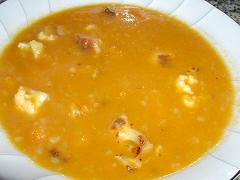 The classic soup of the island is a minestra, a vegetable based soup much like one might find in parts of Italy. To my mind though, that’s about where the similarity ends. I’m used to minestras from various parts of Italy that are heavy on things like beans or peas, perhaps some rice or pasta, and tending towards a broth with vegetables in it – not that there aren’t richer, stew-like versions, but this one struck me as unusual. As its base, I used what amounts to a pretty classic mirepoix – carrots, celery, and onions, along with a little tomato and a nice dose of tomato paste. Though the traditional calls for a meat stock, I used a vegetable stock, which is pretty much based on those same vegetables, but just enriching the stock with more – caramelizing them first, then cooking through in the stock and some added rice, then pureeing that to get a thick broth. Separately, I sauteed diced squash and cauliflower florets until they were lightly browned. I added them at last minute to the broth just to rewarm them. The seasoning, simply salt and black pepper.
The classic soup of the island is a minestra, a vegetable based soup much like one might find in parts of Italy. To my mind though, that’s about where the similarity ends. I’m used to minestras from various parts of Italy that are heavy on things like beans or peas, perhaps some rice or pasta, and tending towards a broth with vegetables in it – not that there aren’t richer, stew-like versions, but this one struck me as unusual. As its base, I used what amounts to a pretty classic mirepoix – carrots, celery, and onions, along with a little tomato and a nice dose of tomato paste. Though the traditional calls for a meat stock, I used a vegetable stock, which is pretty much based on those same vegetables, but just enriching the stock with more – caramelizing them first, then cooking through in the stock and some added rice, then pureeing that to get a thick broth. Separately, I sauteed diced squash and cauliflower florets until they were lightly browned. I added them at last minute to the broth just to rewarm them. The seasoning, simply salt and black pepper.
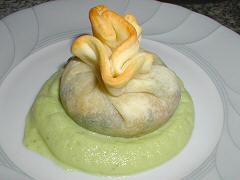 The dish I got the most compliments on when we had our recent Asian vegetarian dinner was the beggar’s purse, and so it was in the back of my mind. Once having decided on including in our menu a lampuki pie, it came to mind again. Normally more of a traditional pie style – a crust on bottom and top with fish (lampuki = dorade, a classic Mediterranean fish) and vegetables inside. I decided to split up the vegetables a bit, going back to the beggar’s purse – so I pulled out the cauliflower, mint, and lemon peel, and turned those (after boiling the cauliflower) into a puree with just a touch of milk to smooth it out. The rest of the recipe – the fish (no dorade available in this season, I used hake), onion, peas, tomato, black olives, garlic, and spinach all sauteed together, cooled, and then stuffed into the beggar’s purse, which were browned to order. The recipe also calls for hard boiled egg, which I left out intentionally. I had meant to garnish the dish with toasted sesame seeds, which are part of the traditional pie, but simply forgot. It happens…
The dish I got the most compliments on when we had our recent Asian vegetarian dinner was the beggar’s purse, and so it was in the back of my mind. Once having decided on including in our menu a lampuki pie, it came to mind again. Normally more of a traditional pie style – a crust on bottom and top with fish (lampuki = dorade, a classic Mediterranean fish) and vegetables inside. I decided to split up the vegetables a bit, going back to the beggar’s purse – so I pulled out the cauliflower, mint, and lemon peel, and turned those (after boiling the cauliflower) into a puree with just a touch of milk to smooth it out. The rest of the recipe – the fish (no dorade available in this season, I used hake), onion, peas, tomato, black olives, garlic, and spinach all sauteed together, cooled, and then stuffed into the beggar’s purse, which were browned to order. The recipe also calls for hard boiled egg, which I left out intentionally. I had meant to garnish the dish with toasted sesame seeds, which are part of the traditional pie, but simply forgot. It happens…
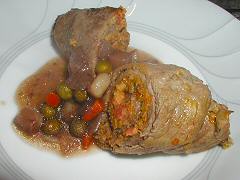 Next up, fitting in with one of my favorite ways to serve beef, a roulade, or in this case, bragoli. The filling is a sauteed mix of finely diced bacon, ground beef, parsley, lots of grated carrot, breadcrumbs, salt and pepper. After cooling, it’s spread on pounded thing steaks (it’s so convenient here that you can get good cuts of meat pre-cut into milanesas), then rolled up, browned on the outside and tossed in the oven to finish cooking through. The sauce is a mix of onion, tomato, carrot, peas, and potatoes cooked down in beef stock with red wine, bay leaves, ground cloves, and just a touch of worcestershire sauce – has to be that British influence, no? After all, here they call it salsa inglés! I cooked the sauce down until the liquid was mostly evaporated and fairly thick, which made it nice to spoon over the cut open roulades.
Next up, fitting in with one of my favorite ways to serve beef, a roulade, or in this case, bragoli. The filling is a sauteed mix of finely diced bacon, ground beef, parsley, lots of grated carrot, breadcrumbs, salt and pepper. After cooling, it’s spread on pounded thing steaks (it’s so convenient here that you can get good cuts of meat pre-cut into milanesas), then rolled up, browned on the outside and tossed in the oven to finish cooking through. The sauce is a mix of onion, tomato, carrot, peas, and potatoes cooked down in beef stock with red wine, bay leaves, ground cloves, and just a touch of worcestershire sauce – has to be that British influence, no? After all, here they call it salsa inglés! I cooked the sauce down until the liquid was mostly evaporated and fairly thick, which made it nice to spoon over the cut open roulades.
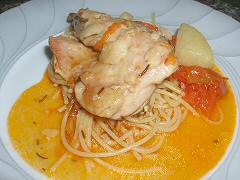 One of the traditions from history of the Mnarja festival was that it was the one day a year when the common folk were allowed to hunt and eat rabbit. The rest of the year, the wild rabbits were the sole property of the Knights of Malta. So rabbit recipes abound for the festival, and the most popular seems to be the fenkata – a stewed rabbit served over spaghetti. It’s a pretty simple recipe – the rabbit is cut into serving pieces (six per rabbit), and then browned in good olive oil with lots of rosemary and garlic. The pieces are set aside, and then to the oil are added carrots, potatoes, and tomatoes. Cook them for a little bit until lightly golden. Add the rabbit pieces back to the pan, top off with beef stock, cover the pan, and cook over low heat for at least an hour, until the vegetables and rabbit are tender. Serve over spaghetti. This recipe sounded so good that I didn’t mess with it at all…
One of the traditions from history of the Mnarja festival was that it was the one day a year when the common folk were allowed to hunt and eat rabbit. The rest of the year, the wild rabbits were the sole property of the Knights of Malta. So rabbit recipes abound for the festival, and the most popular seems to be the fenkata – a stewed rabbit served over spaghetti. It’s a pretty simple recipe – the rabbit is cut into serving pieces (six per rabbit), and then browned in good olive oil with lots of rosemary and garlic. The pieces are set aside, and then to the oil are added carrots, potatoes, and tomatoes. Cook them for a little bit until lightly golden. Add the rabbit pieces back to the pan, top off with beef stock, cover the pan, and cook over low heat for at least an hour, until the vegetables and rabbit are tender. Serve over spaghetti. This recipe sounded so good that I didn’t mess with it at all…
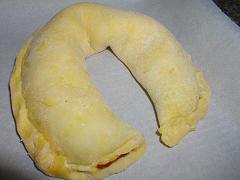 Doesn’t that look pretty? That’s the uncooked Qaghaq t’al-Ghasel, or treacle ring – a little Arab and Brit influence all in one. Okay, I didn’t form them into rings, more of horseshoes, because it was easier given that I was going to cut each into three pieces and serve – and also I thought I could seal them better that way – silly me… I get asked regularly what I do when kitchen disasters befall, because inevitably, things do go wrong on occasion – usually minor and easily correctable or even ignorable, but now and again, potentially disastrous – or at least flops. And sure enough,
Doesn’t that look pretty? That’s the uncooked Qaghaq t’al-Ghasel, or treacle ring – a little Arab and Brit influence all in one. Okay, I didn’t form them into rings, more of horseshoes, because it was easier given that I was going to cut each into three pieces and serve – and also I thought I could seal them better that way – silly me… I get asked regularly what I do when kitchen disasters befall, because inevitably, things do go wrong on occasion – usually minor and easily correctable or even ignorable, but now and again, potentially disastrous – or at least flops. And sure enough, 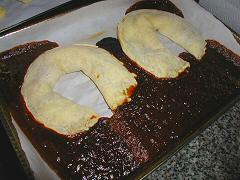 it happened here – despite the fact that I thought the pastry was nicely folded over and sealed all around, each and every one of the four rings burst in the oven, spewing their treacly insides all over the baking pans. Thankfully, sufficient remained inside to let them slightly cool, remove them from the gooey mess, cut them, and still serve them – just not as firm and fully packed – though perhaps a good thing, given that, let’s face it, treacle is really, really, really sweet. It’s also not available here, so I made a substitute out of a mix of more or less equal parts of dark molasses, honey, and light corn syrup.
it happened here – despite the fact that I thought the pastry was nicely folded over and sealed all around, each and every one of the four rings burst in the oven, spewing their treacly insides all over the baking pans. Thankfully, sufficient remained inside to let them slightly cool, remove them from the gooey mess, cut them, and still serve them – just not as firm and fully packed – though perhaps a good thing, given that, let’s face it, treacle is really, really, really sweet. It’s also not available here, so I made a substitute out of a mix of more or less equal parts of dark molasses, honey, and light corn syrup. 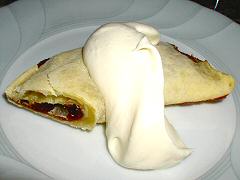 The treacle is then cooked down with finely chopped peel of orange, lemon, and tangerine, a pinch of cloves, and thickened with semolina flour. The pastry is a simple flour, butter, egg yolk, and water dough, left to rest, then rolled out into strips, filled with the treacle mixture, folded over and, more or less, sealed, and then baked. I found the dough to be a little dense, which is perhaps traditional, but I think I’d like this better if it was a little lighter and flakier.
The treacle is then cooked down with finely chopped peel of orange, lemon, and tangerine, a pinch of cloves, and thickened with semolina flour. The pastry is a simple flour, butter, egg yolk, and water dough, left to rest, then rolled out into strips, filled with the treacle mixture, folded over and, more or less, sealed, and then baked. I found the dough to be a little dense, which is perhaps traditional, but I think I’d like this better if it was a little lighter and flakier.
Overall, a fun dinner! And an interesting exploration of a place that I simply knew next to nothing about beforehand.
Isn’t malta something you drink? Like a chocolate or vanilla malta? In any case, the cuisine sounds very tasty.